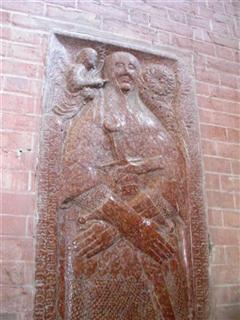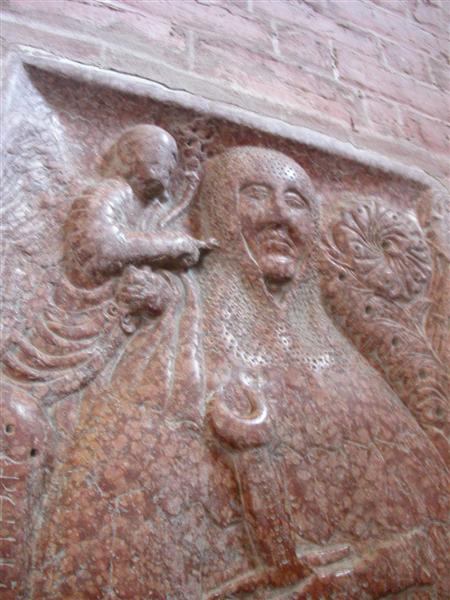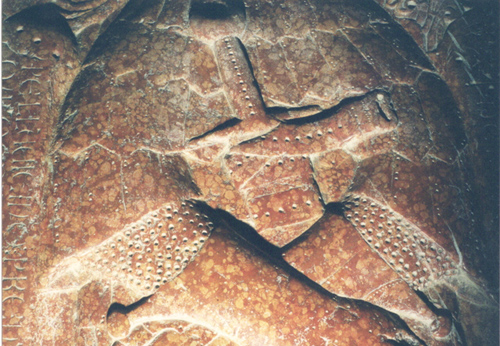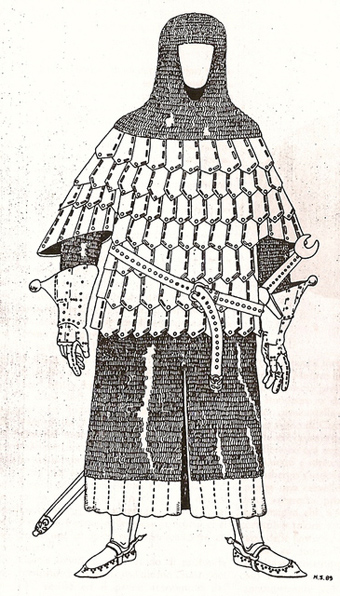Thanks, J.D.! I wish they hadn't discontinued it; it's beautiful. I see now why I thought it was the Norwegian one: the more curved guard and the metal ferrules. But you're right, the blade more closely matches that of the Cawood sword.
The Type O is looking marvelous.
| Tim Lison wrote: |
| Damn! I'm very envious of this sword right now. JD! You are my Moriarty! Why must you always make me want to spend more money on swords? Especially the day I did my taxes and know what my refund will be. :D Your taste is great. I can't say enough good words about this sword and about Craig's willingness to document its creation (not to mention his talent!). Kudos, sir, kudos. |
Ahhh Holmes, it seems you've caught on to my nefarious plan, but far too late. If only you hadn't interfered with my agents so many times, none of this would be necessary. And that that sly comment to the police about a professor not being able to afford of work of art like this....
| J.D. Crawford wrote: | ||
Ahhh Holmes, it seems you've caught on to my nefarious plan, but far too late. If only you hadn't interfered with my agents so many times, none of this would be necessary. And that that sly comment to the police about a professor not being able to afford of work of art like this.... |
Soon I'll have what's needed to thwart your nefarious plan....a new custom sword of my own! Ahh, I fell for his trap! ;)
Did you and Craig discuss the grip or is he going to surprise you?
Wow! Beautiful!!!
Other than some very general guidelines (i.e., leather) I'm leaving it up to Craig to decide the grip on this one, including the color and any underwrap design. He's told me one interesting idea he has - I guess we might see this next week. -JD
Fontevivo Abbey founded in 1142. (Parma - Italy)
the tomb of Guido Pallavicini, Templar Knight who died in 1301.
a masterly work, great choice.
 Attachment: 22.01 KB
Attachment: 22.01 KB

 Attachment: 56.77 KB
Attachment: 56.77 KB

the tomb of Guido Pallavicini, Templar Knight who died in 1301.
a masterly work, great choice.


Thanks Maurizio!
That's extremely interesting - 'O' is supposed to be a German type, and here it is 'in the hands' of an Italian Knight, and a Templar no less! There is also supposed to be some connection between type O/N and the Teutonic Order, based on the distribution of finds; I wonder if there could have been some inter-order conection here. One can only speculate.
The other thing that interests me is that all of these example in Art show such a strong curvature compared to the 2-3 known archeological examples. Is it possible that the archeological finds are just transitional forms from N to O, and there were much more strongly curved O pommels in history? Was this the latest, final form? Or was this just artistic liscence? I know little of medieval art, but from what I have read, they tended to be quite literal and use real props as models.
-JD
That's extremely interesting - 'O' is supposed to be a German type, and here it is 'in the hands' of an Italian Knight, and a Templar no less! There is also supposed to be some connection between type O/N and the Teutonic Order, based on the distribution of finds; I wonder if there could have been some inter-order conection here. One can only speculate.
The other thing that interests me is that all of these example in Art show such a strong curvature compared to the 2-3 known archeological examples. Is it possible that the archeological finds are just transitional forms from N to O, and there were much more strongly curved O pommels in history? Was this the latest, final form? Or was this just artistic liscence? I know little of medieval art, but from what I have read, they tended to be quite literal and use real props as models.
-JD
Great post Maurizio! That is such a cool effigy!
Who knows what swords exist under the earth waiting to be found? Perhaps there is a type O with a more signifigant curve.
I'm attaching a pic of a dagger with such a pommel. It doesn't prove anything of course and is said to be from the 13th/14th century, but at least we know its possible...
 Attachment: 21.04 KB
Attachment: 21.04 KB

Who knows what swords exist under the earth waiting to be found? Perhaps there is a type O with a more signifigant curve.
I'm attaching a pic of a dagger with such a pommel. It doesn't prove anything of course and is said to be from the 13th/14th century, but at least we know its possible...

Last edited by Tim Lison on Tue 22 Feb, 2011 4:39 pm; edited 1 time in total
| Tim Lison wrote: |
| I'm attaching a pic of a dagger with such a pommel. It doesn't prove anything of course and is said to be from the 15th century, but at least we know its possible... |
It's not a 15th century dagger, it's 13th/14th as the book says. Perhaps you're confused by the caption labeling. That dagger is item 52.
That is a great looking sword J.D. I've been away for awhile and this was one of the first things that caught my interest. COngratulations to you and a hearty good job to Craig and the gang at A&A. This gets me wanting another custom sword. :( Unfortunately it is not in the finances now nor in the foreseeable future.
@ JD Crawford
Tim, in his first post shows a pommell with a strong curvature. (in Maciejowski Bible)
This is very similar. Very interesting your theory about the evolution of two types
@Tim
Tim I have to correct the date of this knife is 13/14 century. It 's a photo from the book
"Europaische Hieb und Stich Waffen" - Heinrich Muller - Hartmut Kolling - J. Neumann - ISBN 3-7888-0431-9 pag. 177
Tim, in his first post shows a pommell with a strong curvature. (in Maciejowski Bible)
This is very similar. Very interesting your theory about the evolution of two types
@Tim
Tim I have to correct the date of this knife is 13/14 century. It 's a photo from the book
"Europaische Hieb und Stich Waffen" - Heinrich Muller - Hartmut Kolling - J. Neumann - ISBN 3-7888-0431-9 pag. 177
| Chad Arnow wrote: | ||
It's not a 15th century dagger, it's 13th/14th as the book says. Perhaps you're confused by the caption labeling. That dagger is item 52. |
Erm, ahh, well, yes. What Chad and Maurizio said actually. I've edited my post as I can't read it seems. :blush:
| Chad Arnow wrote: | ||
It's not a 15th century dagger, it's 13th/14th as the book says. Perhaps you're confused by the caption labeling. That dagger is item 52. |
sorry, crossing posts.
Chad, remember? I bought this book after your advice
sorry Tim, you have not had time to correct the error.
We, almost like machine guns in action. :)
The first caption (48) is actually the 15th century.
Easy to get confused, as it is written.
We, almost like machine guns in action. :)
The first caption (48) is actually the 15th century.
Easy to get confused, as it is written.
| J.D. Crawford wrote: |
| Thanks Maurizio!
The other thing that interests me is that all of these example in Art show such a strong curvature compared to the 2-3 known archeological examples. Is it possible that the archeological finds are just transitional forms from N to O, and there were much more strongly curved O pommels in history? Was this the latest, final form? Or was this just artistic liscence? I know little of medieval art, but from what I have read, they tended to be quite literal and use real props as models. -JD |
Note the precision of the holes in his armor.
It is possible that the sword has the same accuracy. Is only a hypothesis.
Strange gloves


Maurizio, I agree, it seems unlikely that the sculptor would be so accurate in every detail and then exaggerate the pommel of the sword. I tend to think these dramatic swords were real.
By the way, our original plan was to make a sword like one in the hands of the St. Peter sculpture at Frieburg Cathedral, which also has a strongly curved pommel and a very wide blade. This is drawn in Oakeshott's SAC. However we did not have a depiction of the full sword, and then we got our hands on drawings of the real sword, so we decided to play it safe with history.
PS - I think that picture of the Templar sword has gotten my imagination going - these N/O swords seem to have reached the end of their run around the same time as the suppression of the Knights templar, 1307. Coincidence? :)
By the way, our original plan was to make a sword like one in the hands of the St. Peter sculpture at Frieburg Cathedral, which also has a strongly curved pommel and a very wide blade. This is drawn in Oakeshott's SAC. However we did not have a depiction of the full sword, and then we got our hands on drawings of the real sword, so we decided to play it safe with history.
PS - I think that picture of the Templar sword has gotten my imagination going - these N/O swords seem to have reached the end of their run around the same time as the suppression of the Knights templar, 1307. Coincidence? :)
Thank you Maurizio
That is a great example and one I had only seen in drawings not in the stone as it where. I have been on a very big search of period art of late. (several different projects, sadly most are my own distractions into weird elements I run across as opposed to paying jobs :eek: ) but I have been finding some quite unique things, but the most striking is the accuracy of the art. Even when I start saying that just can't be some how it turns out to be right. The problem is I don't understand it not that they where being fanciful. That does happen but not as often as one would think.
The effigy seems to be very accurate and the sword quite interesting. Might be a cool project. The crescent does have quite a long history as a symbol and on that would not be lost on folks that had a strong affiliation to it.
Is the effigy life sized?
Best
Craig
That is a great example and one I had only seen in drawings not in the stone as it where. I have been on a very big search of period art of late. (several different projects, sadly most are my own distractions into weird elements I run across as opposed to paying jobs :eek: ) but I have been finding some quite unique things, but the most striking is the accuracy of the art. Even when I start saying that just can't be some how it turns out to be right. The problem is I don't understand it not that they where being fanciful. That does happen but not as often as one would think.
The effigy seems to be very accurate and the sword quite interesting. Might be a cool project. The crescent does have quite a long history as a symbol and on that would not be lost on folks that had a strong affiliation to it.
Is the effigy life sized?
Best
Craig
Crescents through history, a document pulled from an old periodical.
http://files.myopera.com/3sails/files/crescents.doc
Iirc, I included the source link as well
Here is the whole volume url if concerned about the download
http://books.google.com/books?id=NsYEAAAAYAAJ
Fun and interesting stuff to read.
Cheers
GC
http://files.myopera.com/3sails/files/crescents.doc
Iirc, I included the source link as well
Here is the whole volume url if concerned about the download
http://books.google.com/books?id=NsYEAAAAYAAJ
Fun and interesting stuff to read.
Cheers
GC
| Craig Johnson wrote: |
| the most striking is the accuracy of the art. |
Craig- This is a really good observation. I think we have to take into account that effigies were *meant* to look like the person they were representing! (Oddly, it's the definition of the word) The Maciejowski Bible holds another example of a "crescent moon" type O. That book contains some very realistic illustrations. I think you sort of have to take some of the medieval art in context. Imagination and innovation were not encouraged during that time period. It's a pretty dogmatic age. It makes sense that artists would represent what they see instead of make it up. I think just because we don't have a surviving example of something from a Medieval source doesn't mean it didn't exist. Keep up the great work with this sword, I'm becoming pretty damn envious of JD's A&A collection... ;)
I've long been fascinated by the imagery behind historical sword furniture, e.g.,
- the obvious crucifix imagery of the basic knightly sword
- as I've argued elsewhere, certain Viking age grips look remarkably like Thor's hammer amulets
- there are saga references to 'the fist' of the sword, presumably early lobated pommels
The crescent seems like an image of...obviously the moon, but then whatever else that might stand for. I don't know the deep history of this particular image, but based on cartoons and such that we grew up with, it seems to be associated with some kind of wizardry. I was half joking above about the fall of the Templars, but it doesn't seem outlandish that certain sects would use certain symbols....and this might be remembered in a distorted fashion down the centuries (like the date Friday 13). And if that particular image was associated with certain esoteric aspects of the knightly orders, I would sure drop it like a hot potatoe after seeing what happened to the Templars. (Remembering that from real evidence, this pommel has more of a Teutonic association).
Probably I've read one two many historical novels, but It's certainly fun to speculate about these things. (Better get to bed before I say something even more silly that I'll really regret in the morning.)
- the obvious crucifix imagery of the basic knightly sword
- as I've argued elsewhere, certain Viking age grips look remarkably like Thor's hammer amulets
- there are saga references to 'the fist' of the sword, presumably early lobated pommels
The crescent seems like an image of...obviously the moon, but then whatever else that might stand for. I don't know the deep history of this particular image, but based on cartoons and such that we grew up with, it seems to be associated with some kind of wizardry. I was half joking above about the fall of the Templars, but it doesn't seem outlandish that certain sects would use certain symbols....and this might be remembered in a distorted fashion down the centuries (like the date Friday 13). And if that particular image was associated with certain esoteric aspects of the knightly orders, I would sure drop it like a hot potatoe after seeing what happened to the Templars. (Remembering that from real evidence, this pommel has more of a Teutonic association).
Probably I've read one two many historical novels, but It's certainly fun to speculate about these things. (Better get to bed before I say something even more silly that I'll really regret in the morning.)
Page 4 of 7
You cannot post new topics in this forumYou cannot reply to topics in this forum
You cannot edit your posts in this forum
You cannot delete your posts in this forum
You cannot vote in polls in this forum
You cannot attach files in this forum
You can download files in this forum
All contents © Copyright 2003-2006 myArmoury.com — All rights reserved
Discussion forums powered by phpBB © The phpBB Group
Switch to the Full-featured Version of the forum
Discussion forums powered by phpBB © The phpBB Group
Switch to the Full-featured Version of the forum